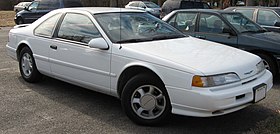Ford Thunderbird (tenth generation)
| Tenth generation Ford Thunderbird | |
|---|---|
 |
|
| Overview | |
| Manufacturer | Ford |
| Production | October 1988–September 1997 |
| Assembly | Lorain, Ohio |
| Designer | Jack Telnack (1986) |
| Body and chassis | |
| Body style | 2-door coupe |
| Layout | FR layout |
| Platform | Ford MN12 platform |
| Related |
Lincoln Mark VIII Mercury Cougar |
| Powertrain | |
| Engine | 3.8 L Essex V6 (1989–1997) 3.8 L Essex Supercharged V6 (1989–1995 Super Coupe only) 4.9 L (302 cu in) Windsor 5.0 V8 (1991–1993) 4.6 L Modular V8 (1994–1997) |
| Transmission |
AOD 4-speed automatic transmission (1989–1993) 4R70W 4-speed automatic transmission (1994–1997) M5R2 5-speed manual transmission (1989–1995 Super Coupe only) |
| Dimensions | |
| Wheelbase | 113 in (2,870 mm) |
| Length | 1989–1993: 198.7 in (5,047 mm) 1994–97: 200.3 in (5,088 mm) |
| Width | 1989–1995: 72.7 in (1,847 mm) 1996–97: 73.2 in (1,859 mm) |
| Height | 1994–97: 52.5 in (1,334 mm) 1994–95 Super Coupe: 53.0 in (1,346 mm) 1989–1993: 52.7 in (1,339 mm) 1991–93 Upper End Model: 53.1 in (1,349 mm) |
| Curb weight | 3,536 lb (1,604 kg) (1989 V6 model) 3,725 lb (1,690 kg) (1995 V8 model) |
| Chronology | |
| Predecessor | Ford Thunderbird (ninth generation) |
| Successor | Ford Thunderbird (eleventh generation) |
The tenth generation of the Ford Thunderbird is a personal luxury car that was produced by Ford for the 1989 to 1997 model years. On December 26, 1988 a completely redesigned Thunderbird was introduced as a 1989 model alongside its sister car, the Mercury Cougar. Developed on Ford's new MN12 (Mid-Size North American Project 12) platform, the new Thunderbird featured a more aerodynamic body that was slightly shorter in overall length relative to the 1988 Thunderbird but had a nine-inch-longer wheelbase.
The car featured a short-long arm (SLA) four-wheel independent suspension, with a modified MacPherson strut assembly in front, that offered excellent handling and ride quality. This setup was significant as it made the Thunderbird and the Cougar the only rear-wheel drive North American domestic cars other than the Chevrolet Corvette to offer a four-wheel independent suspension at the time. Engine options fell to only two for 1989 as Ford dropped the V8 option for the new Thunderbird. The base and LX models were powered by Ford's 3.8 L Essex OHV V6. Producing 140 horsepower (100 kW) at 3800 rpm and 215 lb·ft (292 N·m) of torque at 2400 rpm, many felt the engine was somewhat underpowered for a car that weighed over 3,500 pounds (1,600 kg) in base trim (heavier when equipped with available options). This engine was mated to Ford's AOD 4-speed automatic transmission regardless of trim level from the 1989 to 1993 model years. Thanks in part to its low coefficient of drag, the Thunderbird was relatively fuel efficient considering its overall size and weight. The EPA gave 1989 Thunderbirds equipped with the standard V6 a fuel efficiency rating of 19 mpg‑US (12 L/100 km; 23 mpg‑imp) in city driving and 27 mpg‑US (8.7 L/100 km; 32 mpg‑imp) on the highway, though, like most cars built before 2008, this rating was retroactively reduced by the EPA to reflect newer, more realistic fuel efficiency measurements. The fuel efficiency rating was noticeably better than that of Thunderbirds equipped with higher performance engines and gave the base V6-equipped Thunderbird a significant driving range with its 19 gallon fuel tank (later decreased to 18 gallons).
...
Wikipedia
